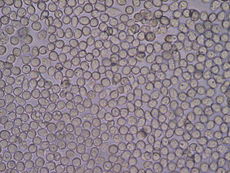24.4D: Urinalysis
- Page ID
- 8149
Urinalysis is the process of analyzing urine for target parameters of health and disease.
- Describe how urinalysis can be used as a method of diagnosis in medicine
Key Points
- The characteristics that can be detected in urine include cells, substances, and properties, such as specific gravity or pH.
- Urinalysis can be performed on test strips (routine) by light microscopy.
- The numbers and types of cells and/or material, such as urinary casts, can yield a great detail of information and may suggest a specific diagnosis.
- Urinary casts include hyaline casts, granular casts, white blood cell casts, red blood cell casts, epithelial cell casts, or bacterial cell casts, which all indicate different abnormalities within urine.
Key Terms
- urinary cast: Tiny structures formed from bound abnormal cells and molecules within the nephrons that are excreted in urine.
- urinalysis: Also known as routine and microscopy (R&M), this is an array of tests performed on urine, and one of the most common methods of medical diagnosis.
Urinalysis
A urinalysis (UA), also known as routine and microscopy (R&M), is an array of tests performed on urine, and one of the most common methods of medical diagnosis. Urinalysis means the analysis of urine, and it is used to diagnose several diseases.
The target parameters that are measured or quantified in urinalysis include many substances and cells, as well as other properties, such as specific gravity. A part of a urinalysis can be performed by using urine test strips, in which the test results can be read as the strip’s color changes. Another method is light microscopy of urine samples.
When doctors order a urinalysis, they will request either a routine urinalysis or a routine and microscopy (R&M) urinalysis; the difference being that a routine urinalysis does not include microscopy or culture. R&M is used specifically for culturing bacteria found in urine, which can make it an important tool for diagnosing specific urinary tract infections.
Test Strip Urinalysis
Test strip urinalysis exposes urine to strips that react if the urine contains certain cells or molecules. Test strip urinalysis is the most common technique used in routine urinalysis. A urine test strip can identify:
- Leukocytes—their presence in urine is known as leukocyturia.
- Nitrites—their presence in urine is known as nitrituria.
- Proteins —their presence in urine is known as proteinuria, albuminuria, or microalbuminuria.
- Blood—its presence in urine is known as hematuria.
- pH—the acidity of urine is easily quantified by test strips, which can identify cases of metabolic acidosis or alkalosis.
Urine Microscopy
The numbers and types of cells and/or material, such as urinary casts, can yield a great detail of information and may suggest a specific diagnosis. A urinary cast is any tiny structure found in urine that consists of multiple molecules or cells bound together.
Casts form within the nephron when abnormal cells and molecules are filtered from blood, and are excreted as the bound structures in urine. Microscopy can identify casts in urine and use them to diagnose kidney diseases, by characterizing symptoms such as:
- Red blood cell casts are associated with glomerulonephritis, vasculitis, or malignant hypertension.
- White blood cell casts are associated with acute interstitial nephritis, exudative glomerulonephritis, or severe pyelonephritis.
- Epithelial cell casts are associated with toxin-induced, acute tubular necrosis, hepatitis, and cytomegalovirus.
- (Heme) granular casts are associated with acute tubular necrosis, and are often composed of proteins, especially antibodies.
- Hyaline casts are associated with dehydration; it is the most common type of cast.
- Bacterial casts are associated with urinary tract infection; the cast may be cultured in order to identify the causative organism of the cast.

Urinalysis: White blood cells seen under a microscope from a urine sample.

